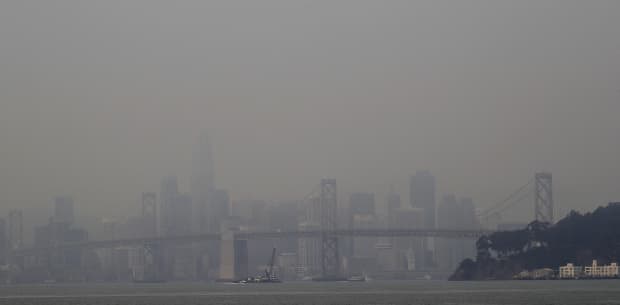This post was originally published on this site

Smoke from wildfires obscures a view of the San Francisco skyline on Wednesday.
Associated Press
Bond investors are fearing California’s heat wave that’s threatened rolling blackouts as the state grapples with its worst power crisis in nearly two decades — and now hundreds of wildfires.
Corporate bonds issued by utility giants Pacific Gas & Electric PCG, -1.38% and Southern California Edison’s parent Edison International EIX, +1.47% have gapped out since last Friday, when the state’s energy-grid operator first warned of possible power outages amid a blistering heat wave.
Then came the wildfires. At last count, nearly 40 were detected in the San Francisco Bay Area as of Wednesday, forcing evacuations of some areas and causing a blanket of ash and smoke to fall on the city of San Francisco, a day after Gov. Gavin Newsom issued a state of emergency for all of California. Statewide, crews are battling more than 360 wildfires, mostly sparked by lightning strikes.
PG&E’s corporate bonds, by far, have been the most actively traded within the utility sector since the blackout warnings were issued Friday, at a nearly 14% market share, according to data tracking platform BondCliq.
Breaking it down further, PG&E’s 30-year bonds due in July 2050 were the most traded for the same period, which saw spreads widen by nearly 10 basis points to about 293 basis points over U.S. Treasurys TMUBMUSD10Y, 0.676%, as of Wednesday.
Bond spreads reflect how much compensation an investor can expect to earn, in excess of a risk-free benchmark, to act as a company’s creditor, with wider spreads often indicating a more risk-averse tone or a lack of demand.
What’s more, PG&E issued another batch of 30-year bonds in June to help the embattled utility emerge from bankruptcy, but with more debt than ever before.
Read: PG&E raises fresh debt as it works toward bankruptcy exit
Those were issued at a spread 200 basis points over Treasuries, but have since gapped out nearly 40 basis points as of Wednesday.
“We’ve been cautious on the utility space that’s connected to California for a while, mainly out of fears of wildfire season,” said Matt Brill, Invesco Fixed Income’s head of U.S. investment-grade corporate credit.
“As we look at this, it’s a different situation than in the past,” Brill said, pointing to recent threats of power outages caused by the heat wave, instead of last year’s blackouts tied to the extreme winds and wildfires.
“But nobody really cares if it’s different, it looks similar to the past,” he said. “With the first signs of smoke, investors are going to get concerned.”
Since Friday, EIX’s 30-year bonds due in 2047 also widened by about 9 basis points, according to BondCliq data.
The move wider in California utility bonds comes as the closely followed ICE BofA US Corporate Index has held relatively steady, near 137 basis points over U.S. Treasurys, as the market has entered the summer doldrums.

